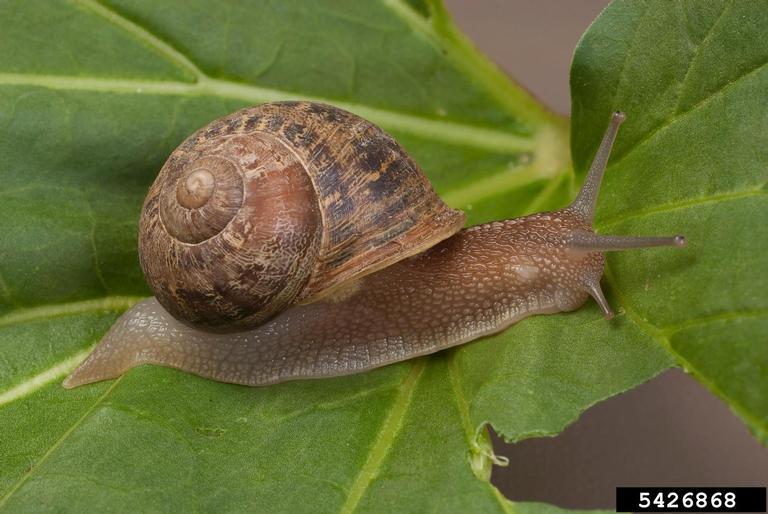 Snail and Slug Management - March 4, 2020 Jeff Schalau, Agent, Agriculture & Natural Resources University of Arizona Cooperative Extension, Yavapai County Snails and slugs are a common garden nuisance. They usually feed on and damage the leaves and stems of young, tender, herbaceous plants, but can also damage fruit, and tender bark of young trees. They especially like strawberries and tomatoes. Snails also feed on decaying vegetation, cardboard, and waste paper. Of course, slugs lack a shell but these mollusks are otherwise similar in structure, biology, and food preferences. In the Verde Valley, you may encounter two types of snails: the decollate snail and the brown garden snail. Decollate snails (Rumina decollata) are predators of juvenile brown garden snails. Even though they are beneficial predators, you should also be aware they eat seedlings, small plants, and flowers. In California, they have been introduced to control the European brown snail (Cornu aspersum) in several counties. The European brown snail can be a very serious garden pest when they become established. This is because mature snails have both male and female sex organs. After they mate, each of the snails will lay a clutch of about 80 eggs. The eggs are small (1/8 to 1/4 inch) and a pearly white color. It takes about two years for the brown garden snail to mature. Each adult snail can lay up to six clutches of eggs per year. Slugs follow a similar pattern, but mature at one year of age. You may not see them because they are nocturnal. However, snail and slug damage is usually easy to identify because they leave a slimy trail. On cool, moist days, you may also notice them out in the daytime. They prefer dark, moist places to hide on sunny days and are generally most active during the growing season. During cold weather, snails hibernate in the soil. In really hot weather, snails have the ability to seal themselves off with a parchment like membrane to minimize moisture loss. Under these conditions, you may find them attached to trees or walls. There are several methods of control and there are tradeoffs associated with each. The best control results when two or more methods are used in concert. Hand picking works for very sparse populations. Start handpicking in the daytime, to reduce the population, then get the flashlight and visit the garden at night. Captured snails can simply be crushed or placed in a sealed plastic bag and discarded. Salt is not recommended because it will raise salinity of the soil. Traps are also easy to use. You can build your own by nailing 1-inch strips crosswise to an 18 to 24-inch-long piece of 1x6. Place it on the ground with the strip side down to allow snails and slugs to crawl underneath it to hide during the day. Check it each morning and discard the catch. Inverted melon rinds are also a good trap. Beer traps are also used, but are not as effective for the labor involved. Besides, beer can always be put to other beneficial uses. Copper flashing or pennies glued to pots were thought to create a barrier that repels snails and slugs through electrical conductivity. Similarly, diatomaceous earth has been suggested as a barrier. In practical application, neither copper nor diatomaceous earth are very effective snail and slug barriers. Bordeaux mixture (copper sulfate and hydrated lime) can also be mixed and painted onto surfaces. Bordeaux treatment is somewhat effective in control and may be effective for about one year. Aside from the decollate snail, there are many other natural predators of snails and slugs. These include toads, snakes, ground beetles, turtles, and domestic fowl (especially geese and ducks). Domestic fowl work well when they have 360-degree perimeter access to fenced garden plots. This “moat” effect also works great for grasshopper and weed management. Baits containing metaldehyde or carbaryl can be hazardous to non-target organisms, such as dogs, cats, wildlife, and children. If you use these products, assess the risks and place the bait in bait traps. Newer, least toxic molluscicides contain iron phosphate. These are safer around pets and wildlife. Iron phosphate does not kill instantly, but it causes the snails and slugs to stop feeding and they eventually die. As with any pesticide, always read the label and follow the directions. See additional information below. You can follow the Backyard Gardener on Twitter – use the link on the BYG website. If you have other gardening questions, call or email the Master Gardener help line in the Prescott (928-445-6590/prescottmg@gmail.com) or Camp Verde (928-554-8992/verdevalleymg@gmail.com) and be sure to include your name, address and phone number. Find past Backyard Gardener columns or provide feedback at the Backyard Gardener web site: http://cals.arizona.edu/yavapai/anr/hort/byg/.  Adult European brown snail, Cornu aspersum (Joseph Berger, Bugwood.org). Additional Resources Snails and Slugs,University of California Agriculture & Natural Resources ipm.ucanr.edu/PMG/PESTNOTES/pn7427.html Brown Garden Snail, Colorado State University Extension webdoc.agsci.colostate.edu/bspm/arthropodsofcolorado/Brown-Garden-Snail.pdf Brown Garden Snail, University of Florida IFAS entnemdept.ufl.edu/creatures/misc/gastro/brown_garden_snail.htmr |